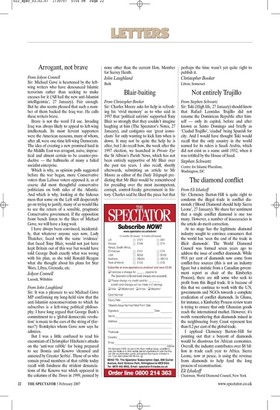The diamond conflict
From Eli Izhakoff Sir: Clemency Burton-Hill is quite right to condemn the illegal trade in conflict diamonds (Blood Diamond should help Sierra Leone', 27 January). We share her sentiment that a single conflict diamond is one too many. However, a number of inaccuracies in the article do merit correction.
At no stage has the legitimate diamond industry sought to convince consumers that the world has 'seen the end of the trade in illicit diamonds'. The World Diamond Council was formed seven years ago to address the issue of conflict diamonds. While 99.8 per cent of diamonds now come from conflict-free sources (this is not an industry figure but a statistic from a Canadian government report as chair of the Kimberley Process), there are still some who seek to profit from this illegal trade. It is because of this that we continue to work with the UN, governments and NGOs towards a complete eradication of conflict diamonds. In Ghana, for instance, a Kimberley Process review team is trying to ensure that only Ghanaian goods reach the international market. However, it's worth remembering that diamonds mined in the neighbouring Ivory Coast represent less than 0.2 per cent of the global trade.
I applaud Clemency Burton-Hill for pointing out that a boycott of diamonds would be disastrous for African economies. Overall, the industry contributes over $8 billion in trade each year to Africa. Sierra Leone, now at peace, is using the revenue from diamonds to help fund the long process of reconstruction.
Eli Izhakoff Chairman, World Diamond Council, New York




















































 Previous page
Previous page